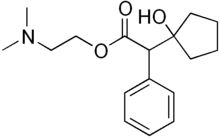Cyclopentolate
 | |
| Clinical data | |
|---|---|
| Pregnancy category |
|
| Routes of administration | Topic |
| ATC code | |
| Identifiers | |
| |
| CAS Number | |
| PubChem CID | |
| DrugBank | |
| ChemSpider | |
| UNII | |
| KEGG | |
| ChEBI | |
| ChEMBL | |
| ECHA InfoCard |
100.007.398 |
| Chemical and physical data | |
| Formula | C17H25NO3 |
| Molar mass | 291.39 g·mol−1 |
| 3D model (JSmol) | |
| |
| |
| | |
Cyclopentolate is a medication commonly used during pediatric eye examinations that dilates the eye (mydriatic), prevents accommodation of the eye to different distances (cycloplegic), and blocks specific receptors called muscarinic receptors (muscarinic antagonist).[1] Cyclopentolate is also administered as an atropine substitute to reverse muscarinic and central nervous system effects of indirect cholinomimetic (anti-AChase) administration.
When used in eye drops in paediatric eye examinations, cyclopentolate 0.5 percent and 1.0 percent are used to stop the eye from focusing at any distance closer than infinity. This enables the ophthalmologist or optometrist to obtain a more accurate reading of the correcting lenses required for clear vision at distance. Brand names include Cyclogyl, Cylate, Mydrilate, and Pentolair.[2]
Cyclopentolate drops act rapidly to dilate the pupil.[3] They have a shorter half-life than atropine. Pupil dilation can last up to 96 hours, with patients advised not to drive a vehicle or operate machinery for at least 12 hours. The pupils become wider when cyclopentolate is administered, making the eyes more sensitive to light. Close objects (and possibly distant objects) will also appear blurred.
Side effects to cyclopentolate are rare, but can include effects such as disorientation, incoherent speech or visual disturbances during the 24-hour period that the drug has an effect. The side effects are more common in children.
References
- ↑ "Cyclopentolate". Retrieved June 15, 2012.
- ↑ "cyclopentolate hydrochloride solution - ophthalmic, Cyclogyl, Cylate, Pentolair". Retrieved June 15, 2012.
- ↑ "Cyclogyl Eye Drops Medsafe data sheet New Zealand" (PDF). 11 January 2017. Retrieved 3 June 2017.